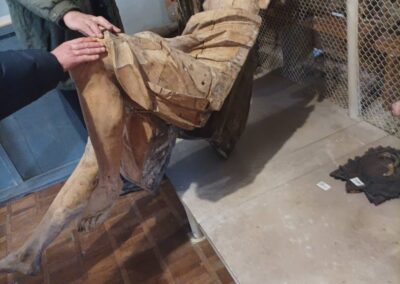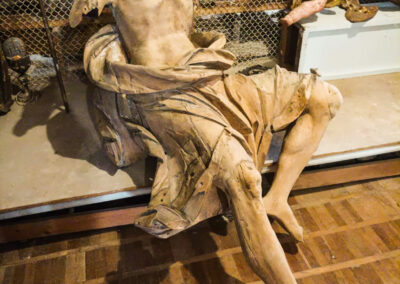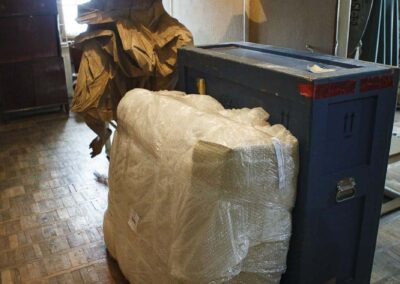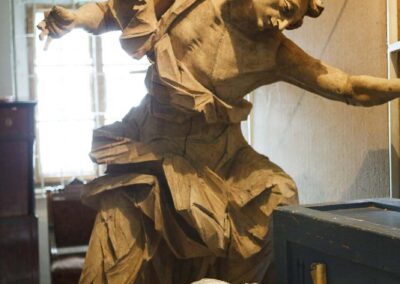On April 14 at the Museo Storico Accademia Carrara in Bergamo, for the first time in Italy, two Baroque statues by the artist Franciszek Olędzki depicting two angels will be exhibited. The director Cristina Rodeschini immediately proved to be one of the institutional figures most sensitive to the issue of saving Ukrainian works of art. Our Foundation has therefore found in the Carrara Academy great support for our project of making Ukrainian history and art known.
17th century angels by Francisk Olenskyi on display at the Accademia Carrara in Bergamo
The Angels
The two Sculptures hosted for the exhibition were used to decorate the interior of the Church of St. Trinity in Berestechko. The I Trinitarian Order of Berestechko is associated with Tomasz Koravskyi, the sub-assessor of Lviv, who, being the owner of the city, allocated land for the construction of a monastery in 1691.
Impressed by how committed the Order of Trinitarians was to education, he started building schools and hospitals and took care of them.
In 1733, Bishop Adam Oransky consecrated the church with the title of Prsv. Trinity and St. John the Baptist.
In 1769 the Trinitarians decided to completely replace the interior of the church, the foundations were laid for the new high altar, the sculpture of which was sculpted by Franzisk Olenskyi.
The angels show two sculptures by Olenskyi from the main altar of this church.
After the divisions of the Polish-Lithuanian Commonwealth, Berestechko went under Russia and since Russia was not close to Catholicism, oppression and persecution of the Western Church began. In 1832 the Russian authorities closed the monastery and the church received the status of a parish church.
During the times of the USSR, the times of the destruction of churches the interior of the Holy Trinity Church in Berestechko was completely destroyed. First, in 1920, the Bolsheviks looted the church and stole Yarema Vyshnevetsky’s saber. In 1943 a mortar shell hit the roof of the church, destroying part of the roof.
In the 1960s, according to eyewitnesses, Komsomol members threw the sculptures from the altars onto the stone floor, destroyed most of them and left the rest exposed to rain and wind, because no one repaired the roof.
The water and humidity have destroyed the lacquers, varnishes and gilding, leaving only the texture of the wood.
The process of destruction of the sanctuary lasted from 1943 to 1973.
In 1973, a small part of the sculptures was rescued by a research expedition of the LKG*, which brought the works to its headquarters, the sculptures were restored and transported to the warehouses of the LKG department inside the Olesky castle.
*LKG – Lviv Art Gallery, today the Lviv National Art Gallery named after B.G. Voznytskyi
ARTIST BIOGRAPHY
Franciszek Olędzki (about 1745, Lviv – end of April 1792) was a sculptor from Lviv of the Rococo period, who lived and worked in the second half of the 18th century. According to some researchers, he was a student of John Georg Pinzel and son-in-law Teodor Polyanskyi, owner of the Lviv foundry. Biography information is almost absent. He was the son of Lviv burgher Andriy (Andrzej).
His wife was Marianna of Polyanskyi, daughter of Teodor Polyanskyi, widow of the sculptor Jan Krushanovskyi. His son was the mason Olensky, who on October 4, 1795 concluded an agreement on the manufacture of the altar of Saints Jack and Vincent Ferrer for the Dominican Church of the Immaculate Virgin Mary (before that, the Jesuit Church) in Yaroslavl. In 1789, Franciszek Olenskyi bequeathed half of the estate to his son Joseph, later remembered as the Lviv sculptor Joseph Olenskyi.
According to Zbigniew Hornung, he probably began his studies with Sebastian Fessinger in Lviv, which he finished at the turn of 1760 and 1770 in the workshop of Pinzel in Buchach, which was of decisive importance for his work. However, Jan Ostrovsky states that there is no information about Olendzky’s stay in Buchach. Dmytro Krvavych believed that Olensky collaborated with Pinzel early in his career immediately after his studies.
In 1773-1779 he worked on the modernization of the interior of the Lviv Roman Catholic cathedral: he performed small masonry and “plaster” works. In particular, together with Jan Obrotsky, the sculptors made 4 altars near the pylons, a throne for the bishop and various ornaments. After Pinzel’s death and the liquidation of his workshop, Mykola Vasyl Pototsky agreed with Olensky on the completion of the works in Buchach around 1775. On October 25, 1780, he signed a contract with the parish priest Dean B. Dulevskii for the construction of a large wooden altar with statues in the collegiate of Zamosta , but the agreement could not be implemented.
In the 1780s he received a large order for the complex interior decoration of the Trinitarian church of Berestechko, the founder of which was a Galician castellan named Tomas Karchevskyi.
Probably, at the beginning of his career, he performed a series of works under the guidance of Pinzel. Pochaiv monastery documents from the 1780s mention an altar sculpture that Olenskiy did not complete, which may indicate broader business ties to the main client, Mykola Vasyl Potocki. For a time, some of Olenskyi’s works were attributed to Pinzel.
Support a specific project.
Adopt a specific project that inspires you or support a larger campaign. Explore the Foundation’s current projects.




